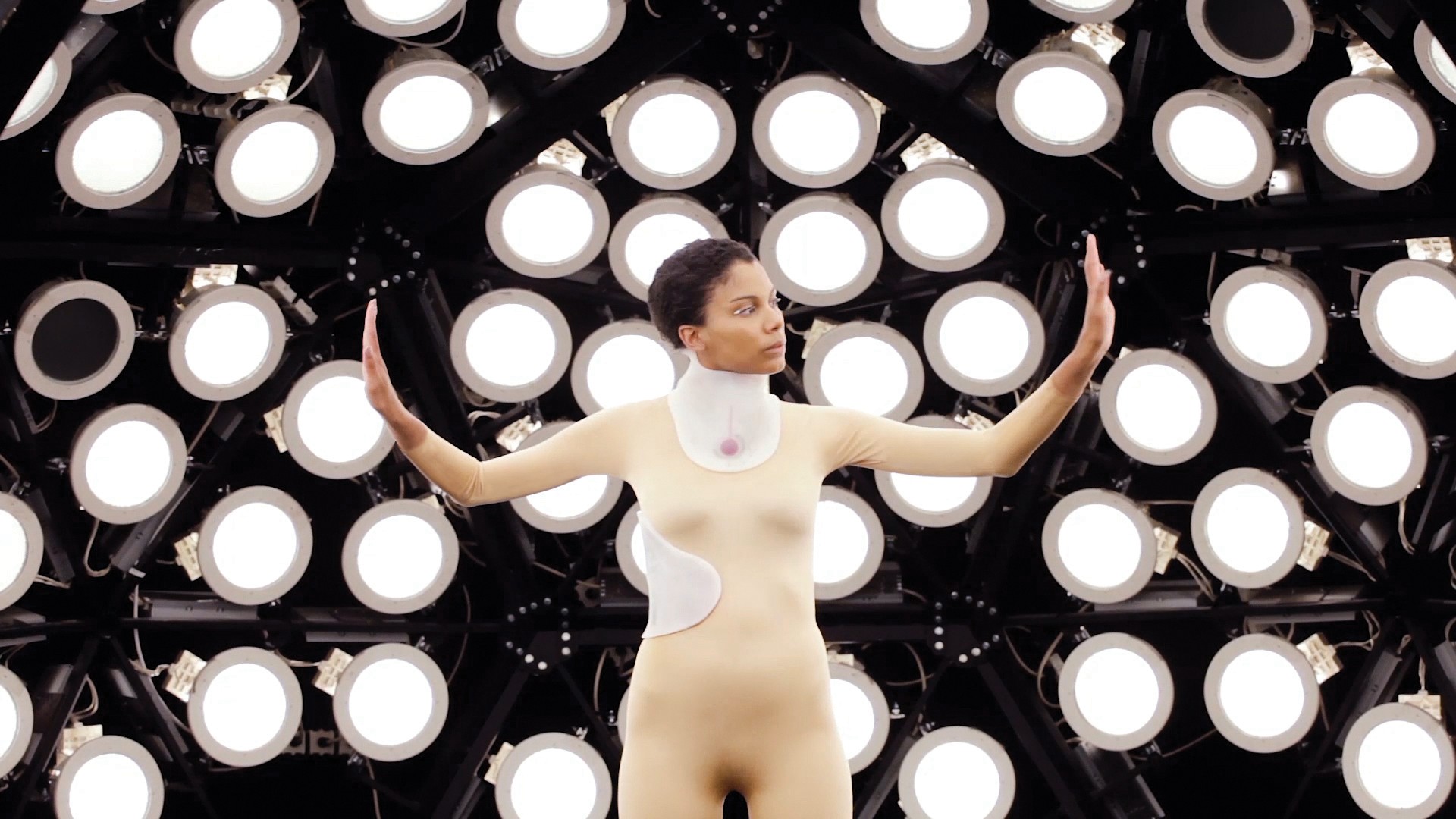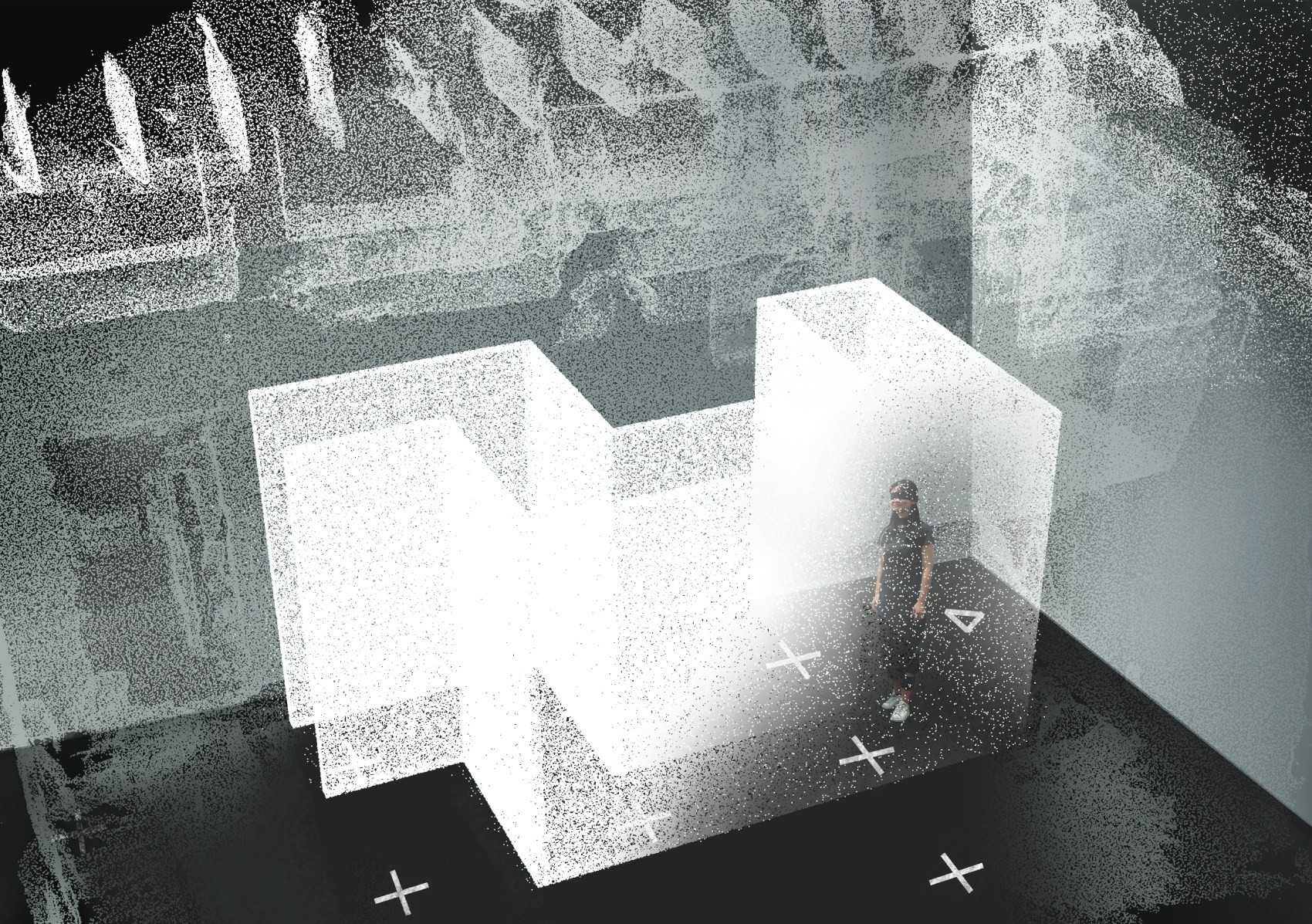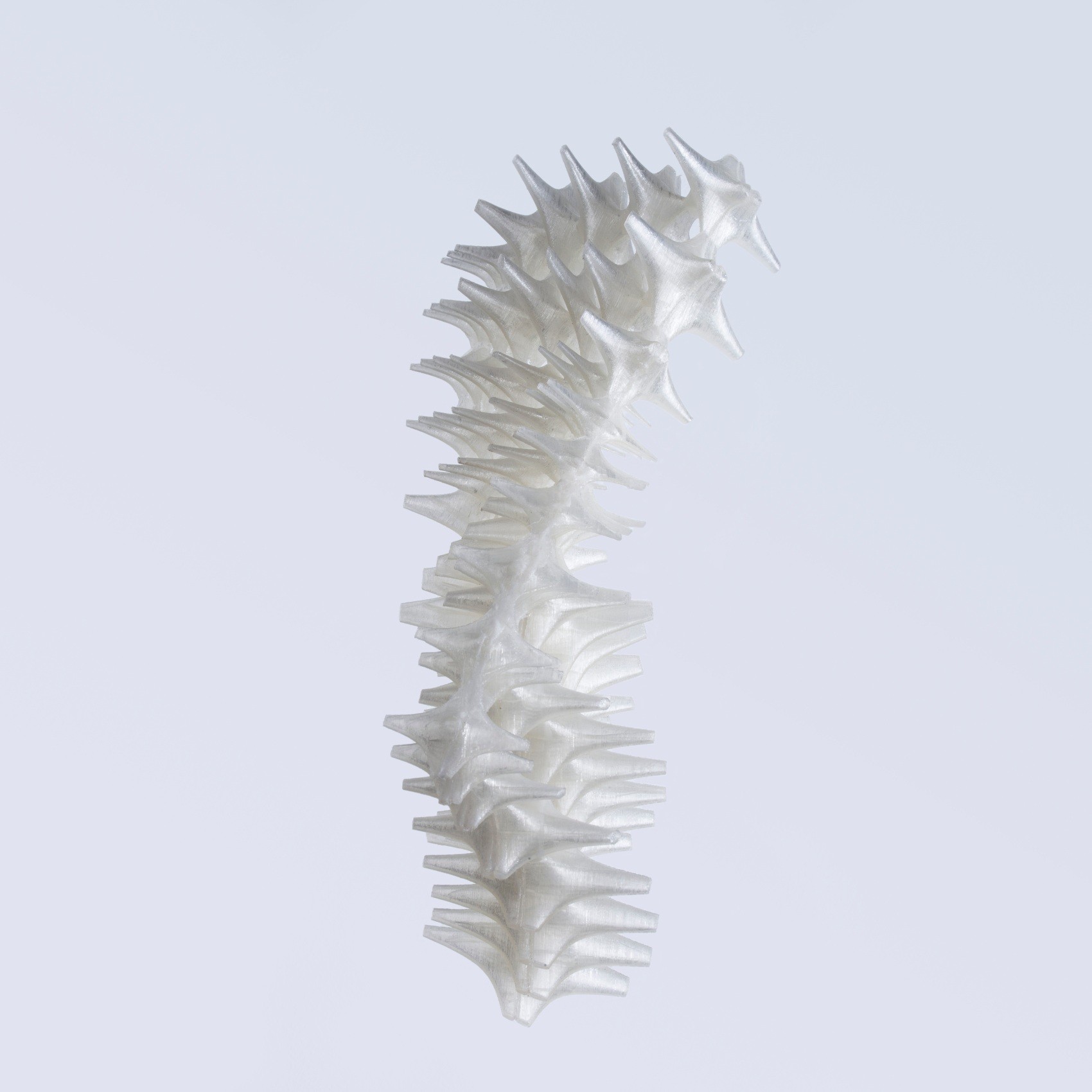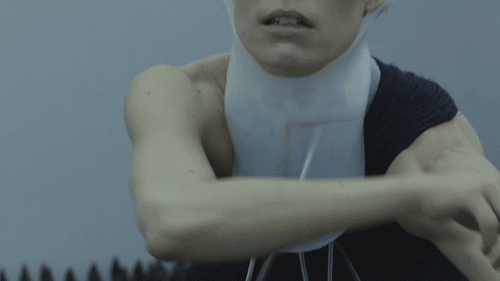Αισθητική και λειτουργικότητα στο διαδραστικό φορέσιμο design
DS.WRITER:
Sophia Throuvala
Κεντρική Εικόνα: MODULAR BONES™: LIVING STRATEGIES, 2021, HD βίντεο, διάρκεια 1:10 min | Έρευνα & σχεδιασμός Μαρία Πανέτα, επιστημονική επιμέλεια Ιωάννης Παπαντωνίου, ηχοτοπίο NatCase
Η Μαρία Πανέτα είναι μια νέα σχεδιάστρια και αρχιτέκτων, με Αρχιτεκτονικές σπουδές σε Λονδίνο και Πάτρα. Ασχολείται με την τέχνη στον διαδραστικό χώρο και με το πώς αυτή μπορεί να χρησιμοποιηθεί στο design, και πιο συγκεκριμένα στη δημιουργία φορέσιμων (wearables). Η Μαρία σχεδιάζει και υλοποιεί φορέσιμα από μαλακά υφάσματα με έξυπνα κυκλώματα, τα οποία είναι διαδραστικά με το σώμα που τα φορά. Εμπνευσμένη από τα προσθετικά της Ρεμπέκα Χορν και τα βιονικά έργα του μοναδικού Stellarc, εξερευνά το μεταίχμιο μεταξύ οικείου και ανοίκειου, δημιουργώντας “ένδυση” που κοιτάζει το μέλλον. Με βάση μελέτες νευροεπιστημόνων για την ευπλαστότητα και δεκτικότητα του εγκεφάλου στη συνεχόμενη επαφή του με κάθε τι παράλογο ή ξένο, σχεδιάζει συνδυάζοντας τη λειτουργικότητα, την αισθητική και τη διεπιστημονικότητα σε έργα που μπορούν να ενταχθούν στο σήμερα αλλά και στο αύριο.
Η Μαρία Πανέτα έχει παρουσιάσει έργα της σε διεθνείς και εγχώριες εκθέσεις. Έχει συνεργαστεί με το μουσείο Victoria & Albert και το Bartlett School of Architecture UCL, όπου δίδαξε “Διαδραστικό σχεδιασμό”. Τέλος, έχει βραβευτεί με το DOMUS best of 2016 και το πρώτο βραβείο digital image του Athens Digital Arts Festival το 2020.
Πες μας λίγα λόγια για τα φορέσιμα (“wearables”). Ποια η σχέση σου με την τεχνολογία και πώς αυτή μπορεί να συντονιστεί με τη μόδα και την αρχιτεκτονική;
Τα Wearables (ελλ. φορέσιμα ή προσθετικά), στο πλαίσιο του πειραματικού design και της τέχνης, αποτελούν προεκτάσεις του ανθρώπινου σώματος οι οποίες επιτρέπουν την αλληλεπίδραση του σώματος που φέρει το φορέσιμο με το κτισμένο περιβάλλον και τους υπόλοιπους χρήστες. Είχα πάντα μεγάλη περιέργεια σχετικά με το πώς η τεχνολογία μπορεί να αποτελέσει εργαλείο για την εξερεύνηση των αισθήσεων. Έκανα πολύ στοχευμένα σπουδή σε διαδραστικές μορφές αρχιτεκτονικής, και άρχισα να μελετώ την κλίμακα του σώματος και το κατά πόσο είναι δυνατό να μεταβληθούν οι αισθήσεις. Οι αναφορές έρχονται από τη νευροεπιστήμη, την ψυχολογία, την τέχνη και το design.
Η τεχνολογία αναμφίβολα σχετίζεται με τη μόδα και την αρχιτεκτονική και είναι πια αλληλένδετη με τα ανθρώπινα σώματα. Είναι, πέρα από καθημερινό εργαλείο, η γέφυρά μας για να συναντάμε τους μελλοντικούς μας εαυτούς. Σύμφωνα με τη Rosi braidotti, “κανείς δεν μπορεί με βεβαιότητα να πει πως είμαστε αμιγώς ανθρώπινοι”.

SAROTIS: WEARABLE FUTURES, 2016, φορέσιμο, HD βίντεο performance | Ava Aghakouchak και Μαρία Πανέτα, Interactive Architecture Lab, UCL, Λονδίνο | mariapaneta.com
Ποια η βαρύτητα της αισθητικής, και ποια η λειτουργικότητα αυτών που δημιουργείς; Ποιες οι αισθητικές προϋποθέσεις για ένα φορέσιμο που ξεφεύγει της μόδας ή της ιατρικής προσθετικής;
Για μένα είναι πολύ σημαντική η νοηματοδότηση κάθε έργου, να γίνονται οι απαραίτητες ερωτήσεις και συνεργασίες για να επικοινωνήσουμε κάθε ιδέα τεκμηριωμένα και άμεσα.
Η αισθητική είναι εξαιρετικά σημαντική, καθώς πλαισιώνει κάθε πτυχή ενός έργου και της επικοινωνίας του με το κοινό. Σχετικά με τη λειτουργικότητα, όταν οι έννοιες που ερευνώνται βασίζονται σε πραγματικά δεδομένα τα οποία προκύπτουν από διαδικασίες data harvesting και πειράματα, φυσικά είναι πολύ σημαντικό να γίνεται ο πειραματισμός σε λειτουργικά και διαδραστικά prototypes.

SAROTIS: EXPERIMENTAL PROSTHESIS, 2016, wearable, HD video, performance | Ava Aghakouchak and Maria Paneta, Interactive Architecture Lab, UCL, London | mariapaneta.com
Στον “Σαρωτή”, που ερευνά το πώς αισθάνεται κανείς αόρατους χώρους, ήταν σημαντικό να χρησιμοποιηθεί μία συσκευή που μετέτρεπε δεδομένα χώρου σε απτική ανατροφοδότηση. Έτσι σχεδιάσαμε και κατασκευάσαμε (Ava Aghakouchak και Μαρία Πανέτα, Interactive Architecture Lab, UCL) μία πειραματική συσκευή, που συνδυάζει τεχνολογία τρισδιάστατης σάρωσης με μαλακά ρομπότ. Με αυτή τη συσκευή το έργο πέρασε και από μία διαδικασία πειράματος, όπου επαληθεύτηκε το ερευνητικό ερώτημα, εάν είναι δυνατό να αισθανθεί κανείς αόρατους χώρους με τη χρήση του. Παρόλο που η συσκευή θα μπορούσε να αναπτυχθεί σε ένα προϊόν για άτομα με μειωμένη όραση και για χρήση σε καταστάσεις περιορισμένης ορατότητας, αποφασίσαμε πως δεν θα της δίναμε ακόμα τα χαρακτηριστικά μιας τέτοιας εφαρμογής. Το έργο Σαρωτής απευθύνεται στη μεγάλη εικόνα του μέλλοντος των ανθρώπινων σωμάτων και την επικοινωνία τους μέσω μαλακών διεπιφανειών και σημάτων αφής.
Στο “Modular Bones™”, από την άλλη, που είναι ένα σενάριο της ζωής μετά την Ανθρωπόκαινο περίοδο, η προσέγγιση είναι θεωρητική και βασίζεται λιγότερο σε διαδραστικά prototypes. Συνεργάστηκαμε με τον Ιωάννη Παπαντωνίου (Associate Professor at KU Leuven) για την επιστημονική επιμέλεια του έργου, σχετικά με το μέλλον των τεχνητών σωματικών μελών, και με τη NatCase για να πλαισιώσει το έργο με το ηχοτοπίο του μελλοντος. Το έργο είναι ένα βίντεο, γλυπτό, ηχοτοπίο, κείμενο, και όχι μία πειραματική διαδραστική συσκευή.

MODULAR BONES™: THE KUN, 2021, τρισδιάστατη εκτύπωση ανακυκλώσιμου προσθετικού | Έρευνα & σχεδιασμός Μαρία Πανέτα, επιστημονική επιμέλεια Ιωάννης Παπαντωνίου, ηχοτοπίο NatCase, φωτογραφία Γιούλη Τσατσοπούλου | mariapaneta.com
Ποια η σχέση του ανοίκειου και του μελλοντικού; Θεωρείς πως μέσω της τέχνης με προηγμένα μέσα και ενός speculative design που συνομιλεί με επαυξημένους τόπους, μπορούν να επιλυθούν προβλήματα που θα προκύψουν στο μέλλον;
Πιστεύω πως μετά την Ανθρωπόκαινο εποχή, την οποία τώρα διανύουμε, η ζωή μας θα είναι πολύ διαφορετική από αυτό που γνωρίζουμε ως τώρα. Μιλάμε συχνά για δυστοπικά σενάρια για το μέλλον της ανθρωπότητας. Στην πραγματικότητα, μόνο εικάζουμε το πώς θα είναι ο κόσμος που θα μας περιβάλλει. Τα φορέσιμα και η τεχνολογία πιστεύω πως θα εξελιχθούν ώστε να κατευθύνουν και να πλαισιώσουν τις νέες συνθήκες ζωής του μέλλοντος, όπως έχουν κάνει ως τώρα. Είμαστε περίπου ανθρώπινοι τώρα και η φυσιολογία μας θα συνεχίσει να είναι τεχνολογικά επαυξημένη και στο μέλλον.
Στο Modular Bones™, που είναι ένα μελλοντικό σενάριο κατοίκησης στη μετά-Ανθρωπόκαινο εποχή, περιγράφεται η ανθρώπινη κοινότητα ως μία τεχνολογικά επαυξημένη ομάδα, που διατηρεί την ανθρώπινη νοημοσύνη και εμπειρία μαζί με τη σωματική της λειτουργικότητα, με τη βοήθεια φορέσιμων. Τα φορέσιμα αυτά, το Kun, είναι ένα έξυπνο αυτο-αναπτυσσόμενο σύστημα, που αποτελείται από ένα σύνολο μεθόδων και μελών.

SAROTIS: WEARABLE FUTURES, 2016, φορέσιμο | Ava Aghakouchak και Μαρία Πανέτα, Interactive Architecture Lab, UCL, Λονδίνο | Απόσπασμα από περφόρμανς για την 150η επέτειο του Harper’s Bazaar στο Μουσείο Σύγχρονης Τέχνης της Σαγκάης, Παραγωγή: Hexagon Collective UK, Δημιουργία: Tong Zhao, Περφόρμερ και χορογράφος: Anna Hermann, Βιντεογραφία: Mitsuru Isshiki, Ενδυματολογία: Xu Zhi, Σχεδιασμός χώρου: Renxiang Li
Πώς σε επηρεάζει η τέχνη της performance στη δουλειά σου;
Η performance είναι σημαντικό κομμάτι της δουλειάς μου, μιας και το ανθρώπινο σώμα είναι πεδίο μελέτης μου. Το έργο “Σαρωτής”, που είναι φορέσιμο, χρησιμοποιεί στοιχεία περφόρμανς προκειμένου να βιντεοσκοπηθεί και να επικοινωνηθεί στο κοινό. Η περφόρμανς συμπεριλήφθηκε με τρόπο αυθόρμητο και αναγκαίο, για να εκφραστεί η ιδέα της εμπειρίας ενός αόρατου χώρου με τη φορέσιμη συσκευή που σχεδιάσαμε και κατασκευάσαμε. Στην πορεία μάς ζητήθηκε το φορέσιμο για μία περφόρμανς για τα 150 χρόνια του Harpers Bazaar στο Μουσείο Σύγχρονης Τέχνης της Σαγκάης, όπου φορέθηκε από τ@ performer Anna Hermann σε χορογραφία τ@ ίδι@. Θέλω να πω πως το μέσο της performans δεν είναι αυτοσκοπός, αλλά αναγκαίο για πειραματισμό, εξερεύνηση ιδεών και επικοινωνία.
ΔΙΕΠΙΣΤΗΜΟΝΙΚΟ ΕΡΓΑΣΤΗΡΙΟ Ε-TEXTILES 2022, Μαρία Πανέτα | Ως μέρος του INTERMIX Residency, του Υπουργείου Πολιτισμού της Σαουδικής Αραβίας: με επικεφαλής και υπό τη διαχείριση της γκαλερί ATHR, εκτελείται από το Manifesto.
Πόσο ευρύ είναι τελικά το πεδίο των φορέσιμων και του διαδραστικού σχεδιασμού;
Τα φορέσιμα και ο διαδραστικός σχεδιασμός έχουν ευρύ πεδίο εφαρμογής, και ένας τρόπος να το προσεγγίσω μέσα από το πρίσμα του πειραματικού design και της τέχνης, είναι τα διεπιστημονικά εργαστήρια. Ξεκίνησα το 2016 στο Sackler Centre του Victoria & Albert Museum, με επιμέλεια της Ειρήνης Μιρένας Παπαδημητρίου, με ένα διήμερο εργαστήριο στη φορέσιμη τεχνολογία κι ένα μονοήμερο course σε ρομποτική. Συνέχισα φέτος στην Αθήνα με ένα εργαστήριο augmented reality και φορέσιμων στο Esto Association κι ένα εργαστήριο e-textiles στο πλαίσιο του Intermix residency καλλιτεχνών στο Ριάντ, με την υποστήριξη της ATHR gallery και του Υπουργείου Πολιτισμού της Σαουδικής Αραβίας. Σημαντικό κομμάτι στα διεπιστημονικά εργαστήρια είναι η επικοινωνία και ο πειραματισμός με δημιουργούς, καλλιτέχνες και άτομα με ενδιαφέρον στο διαδραστικό design και τα νέα τεχνολογικά μέσα.

MODULAR BONES™: THE KUN, 2021, τρισδιάστατη απεικόνιση προσθετικού | Έρευνα & σχεδιασμός Μαρία Πανέτα, επιστημονική επιμέλεια Ιωάννης Παπαντωνίου, ηχοτοπίο NatCase | mariapaneta.com
Ποια είναι η φιλοδοξία σου με τα wearables, και σε ποιον κλάδο θεωρείς ότι κάνουν περισσότερο apply σήμερα; Θεωρείς ότι υπάρχει μια “κοινότητα” δημιουργών στην οποία εντάσσεται σαφώς η δουλειά σου;
Τα wearables αναμφισβήτητα έχουν εφαρμογή στον κλάδο της τεχνολογίας, των έξυπνων ρούχων, των τεχνολογιών εικονικής και επαυξημένης πραγματικότητας. Είναι πλέον πολύ λεπτό το όριο μεταξύ τεχνολογίας, design και τέχνης, καθώς όλα είναι αλληλένδετα και τροφοδοτούν με ιδέες και πρακτικές το ένα το άλλο.
Είναι ο συνδετικός κρίκος ανάμεσα στην ανθρώπινη φυσιολογία, ή ό,τι θεωρούμε πλέον ανθρώπινο, και το διαρκώς μεταβαλλόμενο περιβάλλον, το οποίο πλέον είναι ένα merge τεχνητού, εικονικού και απομειναριών φυσικού. Είναι στο χέρι μας να κάνουμε navigate σε αυτόν τον μοναδικό και διαρκώς μεταβαλλόμενο κόσμο, χωρίς φόβο, με περιέργεια και πάθος.
Σχετικά με την κοινότητα, υπάρχει μία κοινότητα δημιουργών για φορέσιμα, είναι πιο περιορισμένη από άλλες μορφές τέχνης, σίγουρα όμως ενδιαφέρουσα. Το μέλλον των σωμάτων μας είναι σίγουρα άρρηκτα συνδυασμένο με την τεχνολογία, και πιστεύω ότι η αρχιτεκτονική, το design και η τέχνη σίγουρα τροφοδοτούνται από τις νέες τεχνολογικές εξελίξεις και εξελίσσονται από αυτές.

Πορτρέτο της designer Μαρίας Πανέτα από την Ανδριάνα Γκότα, 2022





